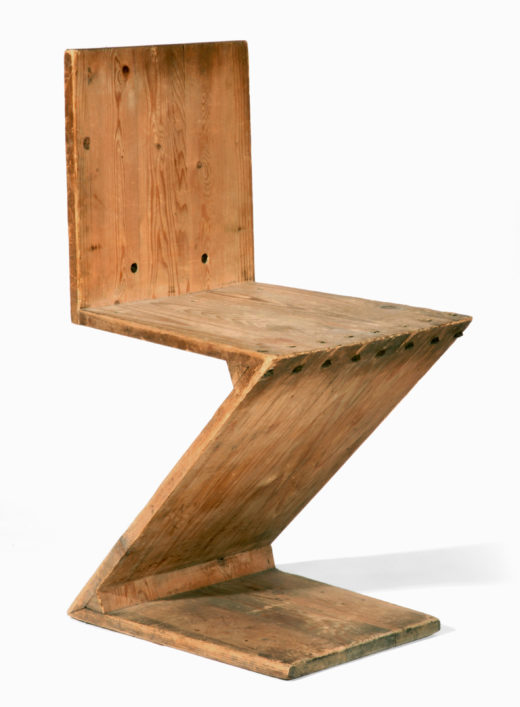Modern Dutch Design: A Collector’s Perspective
Dr. Alberto Eiber

Zig Zag Chair, 1938–40, Gerrit Thomas Rietveld. Image courtesy of the Kirkland Museum of Fine & Decorative Art, Denver
NOVEMBER 18, 2016-JUNE 11, 2017
I recently visited the Modern Dutch Design exhibition at the Wolfsonian–Florida International University in Miami Beach. I was pleased that Silvia Barisione, the exhibition curator, offered to escort me through the educational exhibit. Although I have been collecting design for more than thirty years, I still made many new discoveries walking through the different rooms filled with furniture, lighting, glass, ceramics, books, and an overwhelming collection of posters and graphics.
Modern Dutch Design focuses on design and architecture created in the Netherlands between 1890 and 1940. This particular body of work is considered to be one of the major highlights of Mickey Wolfson’s collection. Mickey began collecting pieces from this period many decades ago, before it was fashionable, and has amassed one of the most comprehensive collections of Modern Dutch design in the world.
The exhibition covers three distinct design movements: the Nieuwe Kunst, the Amsterdam School, and De Stijl—probably the most recognized movement among design collectors. These movements emphasized austere ornamentation and symmetry, differentiating them from their Belgian and French counterparts, which tended toward a flowery and sinuous vocabulary.
My favorite works in the exhibition were the minimalistic and utopian De Stijl pieces. This design movement was founded after Theo van Doesburg and Piet Mondrian launched a journal of the same name that railed against the ornamental excesses of the past. They believed in pure forms, clean lines, and primary colors. De Stijl attracted important figures in the history of modern design such as Gerrit Rietveld, whose Roodblauwe stoel (Red Blue Chair, ca. 1923) and Zig Zag Chair (1932) are some of the most desirable and collected design works of the twentieth century.
In her catalog essay describing the design philosophy during this period, Barisione writes that the Dutch “believed artists should transform daily life by redesigning the environment: interiors, books, calendars, posters, and ephemera.” This philosophy is well exemplified throughout the entire exhibition.
Although much of the extraordinary design and architecture from the modern period was destroyed by the beginning of World War II, there is good news. In the last few decades some of the best architects and industrial designers in the world have emerged from the Netherlands, signifying a new period of fantastic design. Look for pieces by Joris Laarman, Marcel Wanders, Hella Jongerius, Maarten Baas, Studio Job, and others. I believe these are many of the designers you will begin to see in museum exhibitions for decades to come.
Dr. Alberto Eiber is a design collector and writer living in Miami. His blog, SCOOPONDESIGN, aims to let lovers of great design know where to see and where to buy great design–new or old.










